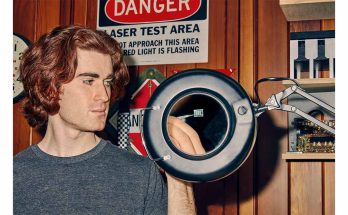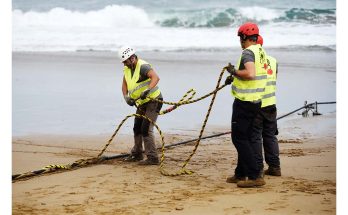
Fiber Optics and Fiber Optic Cabling play a tremendous role in enabling the modern Internet. As with much of the Internet it is virtual, virtually unseen. Fiber optic cables have been laid seemingly any and everywhere, on land and under-sea. This article provides links to stories and images of the wonders of fiber optics. The image above is a map of all global under-sea fiber optic cabling.
Mother Earth Mother Board — First, an article by Neal Stephenson, published in the Dec. 1, 1996 edition of WIRED magazine with the “Epic story of wiring the planet” where he chronicles “the laying of the longest wire on Earth.” It’s a great read, albeit long. (Caveat emptor, don’t let it be TL;DR, it’s better than that.)
Trevor Paglen — Art of Undersea Fiber Optic Cables: Trevor Paglen is an artist whose work spans image-making, sculpture, investigative journalism, writing, engineering, and numerous other disciplines. Among his chief concerns are learning how to see the historical moment we live in and developing the means to imagine alternative futures. In 2014, he received the Electronic Frontier Foundation’s Pioneer Award for his work as a “groundbreaking investigative artist.”
Trevor Paglen: What lies beneath – “We all live under constant covert surveillance. The American photographer’s work seeks to reveal this hidden world.” — An article by Liz Jobey, published in the Dec. 31, 2015 edition of Financial Times.
Trevor Paglen Plumbs the Internet — An article by Tim Sohn, published in the Sept. 22, 2015 edition of The New Yorker magazine.
Submarine Communications Cable catalogs the history of telecommunications cabling from the 1850s to the present and provides the usual bevy of information one would expect from a Wikipedia article.
Porthcurno Telegraph Museum:
The Telegraph Museum — The tiny Cornish village of Porthcurno was once the heart of international telecommunications, boasting the largest telegraph station in the world. Today, the Telegraph Museum Porthcurno is a vibrant and captivating heritage attraction. Discover our World War 2 tunnels, the secret hub of Britain’s wartime communications. Visit the Cable Hut where the underwater cables came ashore. Explore our exhibitions and interactive displays, telling the amazing story of global telecommunications from the first practical use of electricity to how we communicate today, using fibre optic cables that still run beneath the world’s seas and oceans.
The Porthcurno Telegraph Museum is a museum located in the small coastal village of Porthcurno Cornwall, UK. [Wikipedia]
The Microwave Radio and Coaxial Cable Networks of the Bell System (AT&T Long Lines):
Places and Routes: Maps, Diagrams and Lists
Technology and Equipment
Operations
Documents
Sources of Information
Links
Organizations, Museums and Archives
(BTW, this is a great example of what websites used to look like with just basic HTML coding and before the advent of modern Cascading Style Sheets. The AT&T Long Lines site was started in 1999.)
Internet eXchange Point (IXP) Toolkit: Our objective is to create sustainable enabling environments so that local communities build their expertise and are “enabled”. This is all about extending the Internet around the globe. This is all about working with others to build technical capacity, and for others to carry-on and build communities capable of maintaining, sustaining, and extending the benefits to other. People who donate their time, build technical infrastructure, and otherwise are keen to train people who will train others. Join that community of experts.
AT&T Archives: Submarine Cable Systems Development – 1958 Bell Labs
AT&T Tech Channel, Published on Jun 24, 2011
A film from 1958 about the future of broadband submarine cable systems. Emphasis is on the mechanical aspects of cable, repeater, and shipboard machinery development. The need for continuing development work on future broadband cable systems is outlined. The complexity of the project is described and its diverse nature is indicated by the fact that information from the fields of oceanography and microbiological corrosion must be integrated with many types of engineering work on the project.
In 1958, Cable technology had been around for 90 years, but still was in its relative infancy. AT&T had made significant improvements to the technology by incorporating coaxial cable, polyethylene insulation, and vacuum tube repeaters (soon to be transistorized), and through these developments had laid the first transoceanic cable, TAT-1, in 1956. TAT-1 could only carry 36 calls at a time, but also contained a Moscow to Washington DC hotline.
In 1983, fiber optic cables were being developed. By 1988 AT&T was able to lay TAT-8, the first fiber-optic transoceanic cable. It could carry 36,000 calls at a time.
Today the world is encircled by cables, in an ever-increasing net laid above and underground, and under the sea. As of this writing (2011), there are at least 15 undersea cable projects in process around the world, slated to be completed by 2013.
Related Articles & Books
“What Would Really Happen If Russia Attacked Undersea Internet Cables: The world’s internet infrastructure is vulnerable, but snipping a couple of lines is the least of your concerns.”
WIRED.com, January 5, 2018
Security
By Louise Matsakis
“The Undersea Network”
By Nicole Starosielski
Published by Duke University Press, March 2015
In our “wireless” world it is easy to take the importance of the undersea cable systems for granted, but the stakes of their successful operation are huge, as they are responsible for carrying almost all transoceanic Internet traffic. In The Undersea Network Nicole Starosielski follows these cables from the ocean depths to their landing zones on the sandy beaches of the South Pacific, bringing them to the surface of media scholarship and making visible the materiality of the wired network. In doing so, she charts the cable network’s cultural, historical, geographic and environmental dimensions. Starosielski argues that the environments the cables occupy are historical and political realms, where the network and the connections it enables are made possible by the deliberate negotiation and manipulation of technology, culture, politics and geography. Accompanying the book is an interactive digital mapping project, where readers can trace cable routes, view photographs and archival materials, and read stories about the island cable hubs.
See also:





